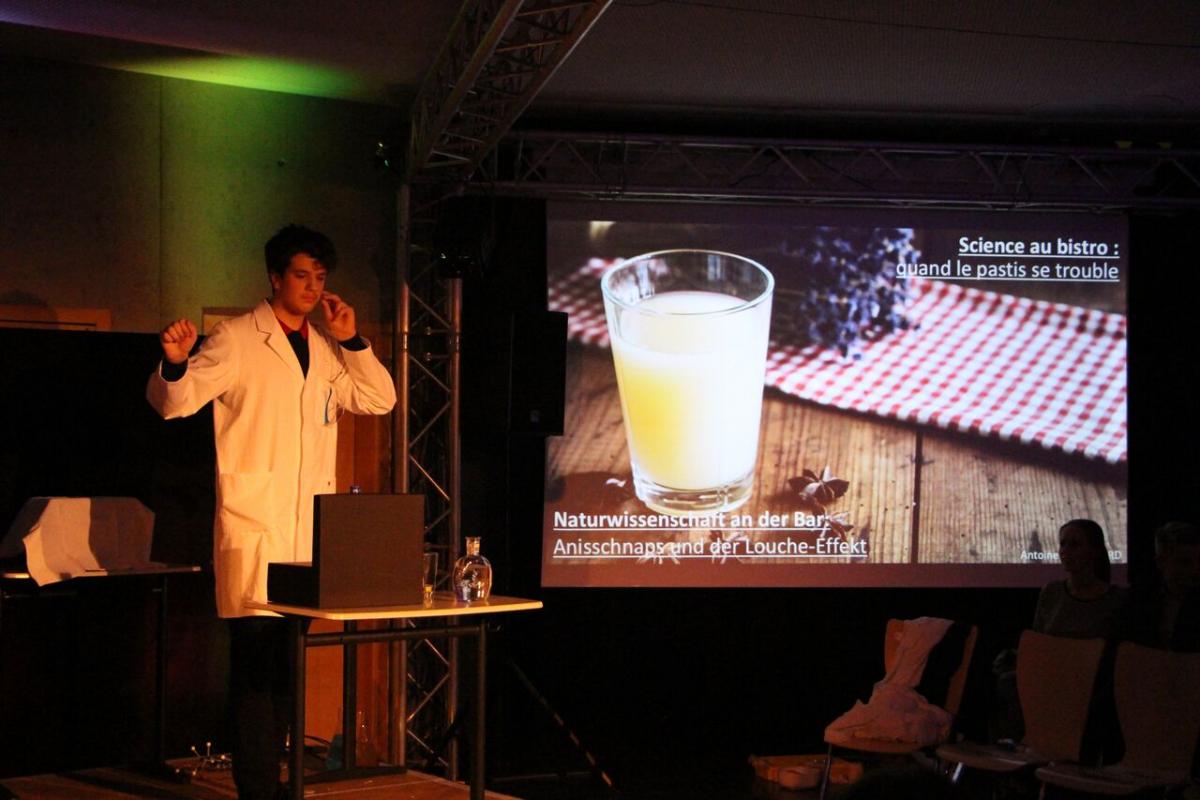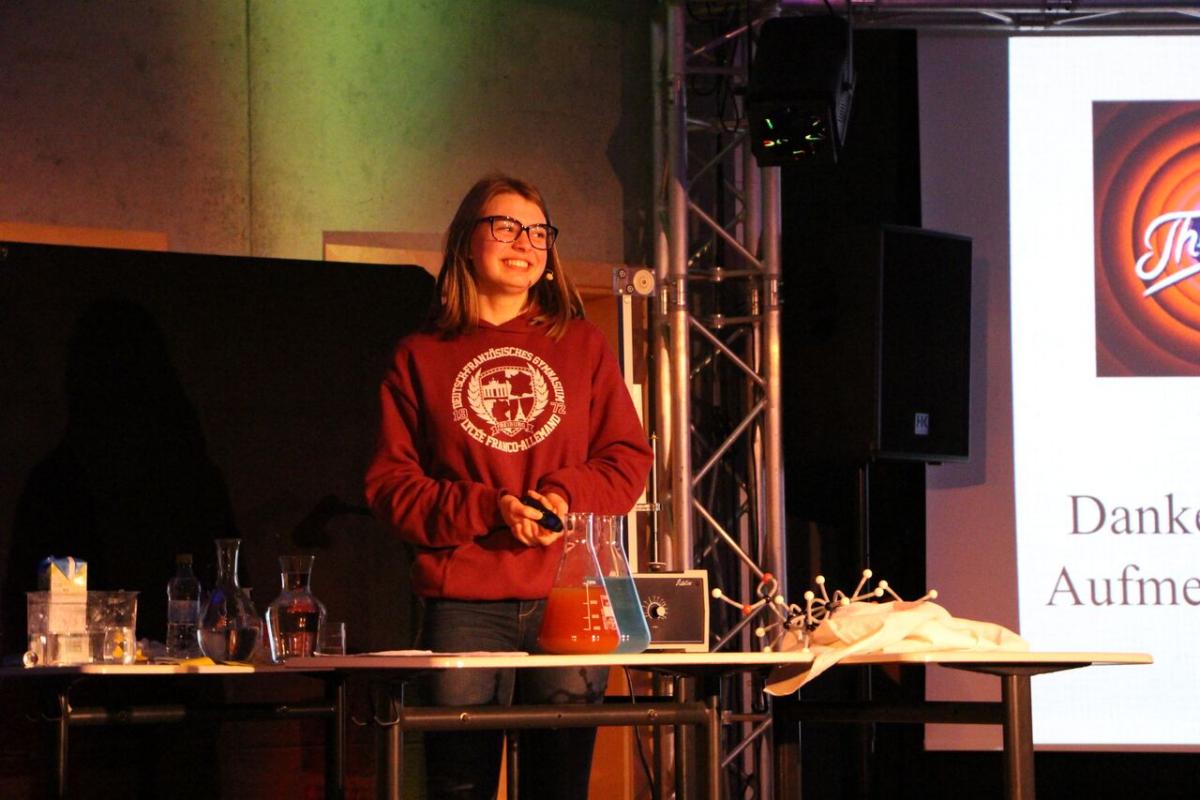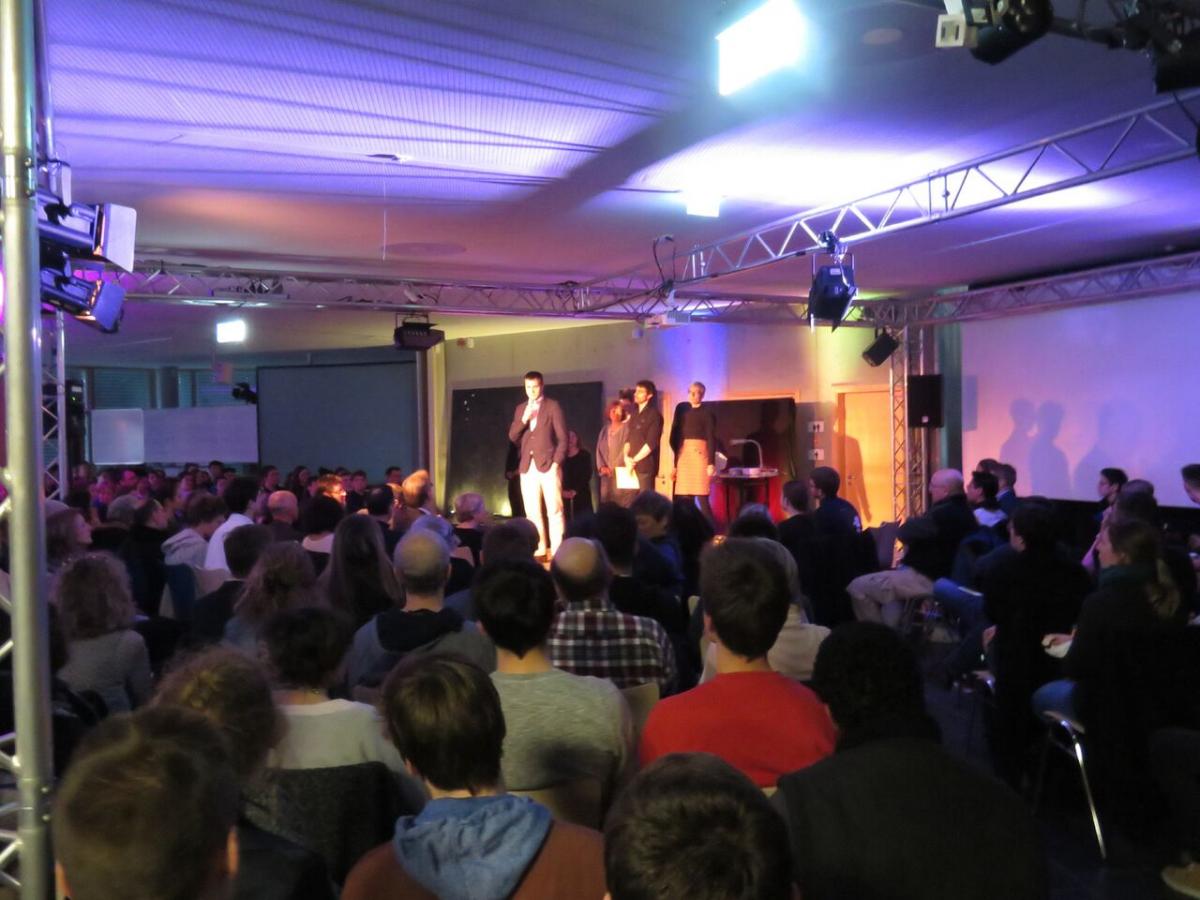Scientific stand-up: organising a student science slam Teach article
Bring students and scientists together for an evening of multilingual scientific entertainment.
In bars, theatres and lecture halls across the world, an event for communicating science is gaining popularity. During the course of an evening, scientists inform and entertain an audience of inquisitive minds. The only rule is that they have just 10 minutes on stage to bring their research to life. The event is known as a ‘science slam’ (like a poetry slam), as scientists go head-to-head to win the audience vote.
In 2014, we adapted the concept for our school, the Franco-German Secondary School in Freiburg, Germany, and hosted our first event, called ‘La Soirée DupleX’. The event gives students the chance to learn from scientists from a variety of fields, and also encourages students to research and present scientific talks of their own.
The name ‘La Soirée DupleX’ stems from the principles of our event, as there are two aims: to communicate scientific research, and to entertain. On-stage experiments and humour are key. Students are also asked to present their talks in two languages (French and German, French and English, or German and English); and there are two types of candidate (students and scientists). It’s a perfect way to bridge the gap between scientists and schools.

Nicola Graf
The final duplex element in the event is that candidates must incorporate two subject areas in their presentations. This can be two scientific disciplines, or one scientific and one non-scientific. For example, candidates have presented talks entitled ‘Crystal clear drug design’ (combining physics and biology) and ‘Genesis as opposed to the Big Bang theory’ (combining physics and philosophy).
Our now-annual Franco-German science slams have continued to evolve since 2014. In March 2018, we expanded the idea and brought together different schools to host an inter-school science slam, which was attended by an audience of 400 pupils, parents, scientists and teachers. For 2019, we have modified the concept to allow students and scientists to team up and present a talk together.
In this article, we describe how to organise a school science slam, in the hope that the concept will continue to spread throughout schools in Europe. Organising one at your school requires input from a team of teachers and students, and parents may be happy to get involved too.
Phase 1: The selection process
We recommend starting to plan your science slam one year in advance. In our experience, the ideal number of presentations for the course of the event is eight. Aim to confirm your speakers a few months before the event.
Choosing the speakers: students
The science slam is most suitable for students aged 14–19. At the beginning of the school year, we give students some presentation guidelines in addition to a marking scheme outlining how they will be judged. A jury of teachers on a committee uses this marking scheme to choose the final candidates. For each school involved in our inter-school science slam, 2–4 jury members are involved in the pre-selection.
We allocate a total of 50 marks to six categories as follows:
- Originality of topics (5 points)
- Clarity of presentation (12 points)
- Scientific approach and accuracy (15 points)
- PowerPoint presentation (6 points)
- Communication skills (6 points)
- Balance of languages and fluency (6 points)
Choosing the speakers: scientists
Approach local universities and businesses to find scientists to present at your science slam. Use your network of parents and former students to help. This is one of the hardest aspects of organising the science slam, but the more events you organise, the easier it becomes to find scientific speakers as your network grows from year to year. For our event in 2018, all three scientists were former students, now studying in the fields of clinical bioinformatics, cancer research and engineering. In past years, we recruited other scientists who were friends of teachers or parents of students.

Guillaume Chevallier
Phase 2: The preparations
Once you have confirmed your speakers, there are a number of other aspects to consider in preparation for your event. These details can be adapted depending on the desired scale of your science slam.
Presentation practice
The preparation phase is an intense period for students, with many of them investing numerous hours of their time to research, write and practice their presentations. Students test out experiments, create eye-catching visuals and aim to make their talks as entertaining as possible. Teachers will need to be available to offer guidance.
One month before the event, we hold a workshop for all the student candidates, which is run by our drama teacher. This helps them with their presentation skills (e.g. articulation, body language, stage presence, use of space) and also improves their self-confidence. Feedback from our students after the workshop is always positive, with many commenting that the skills they gained from the workshop will help them throughout life.
Why not involve your school’s art department too? During the event, students can set up large canvasses at the side of the stage that illustrate the scientific topics as they are being presented. The artists can choose which presentation they want to illustrate before the event, allowing them to practice with the presenter in advance.
Publicity and sponsorship
Invite your school community (students, teachers, parents) to be part of the science slam audience. You may also wish to extend the invitation to other schools, local universities and businesses that are involved in the event – and to consider inviting other organisations, to encourage them to take part the following year. If you have the capacity, you could even open the event up to the general public.
Create posters and flyers, and contact local press agencies to publicise the science slam. If entrance is free of charge, don’t forget to mention it in your advertising. We are very happy to share our templates for posters and flyers – you can find our details at the end of the article.
Depending on the size of your event, you may wish to find organisations to provide sponsorship. This can help cover the cost of prizes, publicity materials, food and drink for the event or any extra equipment you may need, such as stage props, lighting or sound kit.
Finding a jury
After each presentation, a jury (along with the audience) will assess the talks and score them on a scale of 1 to 50 using the same point system from the initial selection. Invite teachers, parents and scientists to be part of the jury, and ask a scientist who hasn’t presented in the slam to act as the jury’s president. The president could also hold a talk or workshop at your school during the day of the event.
In 2018, we formed an ongoing partnership with Eucor – The European Campus, which is a consortium of five universities across three countries. We invited Florence Dancoisne, the local coordinator for Eucor from the University of Freiburg, Germany, to give a talk on the afternoon of the event. In other years, we invited professors from the University of Freiburg and University of Strasbourg, France, and we hope to invite a Nobel Prize laureate in chemistry for next year’s event.

Guillaume Chevallier
Phase 3: The event
At the science slam, a compère should start by welcoming the audience, introducing the jury, and giving an outline of the event. They could also introduce each presentation in turn. This year, we asked students who had applied to present at the science slam but who had not been chosen for the final to host the event, so they could still participate in some way. For the presentations, a stopwatch should be easily visible to speakers so they can gauge the timing of their talk. You could use lighting or sound effects to indicate when their 10 minutes are up.
Audience voting
The audience should be grouped into ten teams and each team should be given five cards with the numbers 1–5 clearly marked. At the end of each presentation, the team decides on a score to give (with 5 being the best) and, when requested, they reveal their card. A small team of students can record the scores and hand these in to the jury. The total audience score (like the jury’s) gives a mark out of 50. Past experience has taught us to avoid using a clapometer as this method is inaccurate and does not encourage audience interaction.
Scores from the jury
The jury’s scores should not be revealed until the end of the event. This leaves an element of suspense and allows the jury to confer and agree on its scores after all the speakers have given their talks. It is worth remembering that the first speaker is at either an advantage or disadvantage because the audience does not yet have any comparison.
Announcing the winner
Add up the scores from the audience and jury (a total of 100 points) to determine the two winners of the science slam – one from the scientist category, and one from the student category. The candidates put a lot of work into their talks, so prizes are a good way to motivate them and show your appreciation. Local businesses are often keen to donate prizes or offer sponsorship to encourage young scientists.

Guillaume Chevallier
Spreading the word
We hope this article has sparked your interest and encourages more teachers to organise science slams across Europe and beyond. Remember, you can tailor your science slam to suit the needs and circumstances of your school. Whatever the extent of your event though, you can be sure that it will be a fulfilling experience for all involved. Do not hesitate to send us an email (chevallier@dfglfa.net, field@dfglfa.net) for more information.
Our 2019 science slam will be held on Friday 17 May in Freiburg, Germany. We are happy to welcome anyone who is interested in attending and seeing us at work!
Resources
- Watch a short video (in English, French and German) outlining the ‘La Soirée DupleX’ science slam.
- Watch a video (in English, French and German) from the 2017 science slam, featuring interviews with participants and organisers.
- To view and download materials from past science slam events, visit the author’s Padlet page.
- Find more information regarding past and future science slam events on the Franco-German Secondary School website.
Review
This article outlines how to organise a science slam, an event that enables science to be explained and shared in different ways. The article provides lots of help and advice for teachers who might be interested in organising an event like this for the first time.
At a time when fake news is plentiful, it is essential to disseminate science while promoting critical thinking and rationality. A science slam is a great way of spreading science to schools and the general public, and reminds us of the importance of science for society.
Dr Bartolome Piza Mir, science teacher, CC Sant Vicenç de Paül Sóller, Spain





